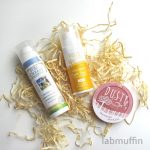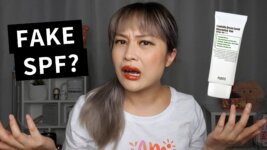I ran into this myth twice today.
The first time I saw it I thought there was no way anyone could believe it, because it was so damn ridiculous.
The second time I saw it I realised maybe I knew a lot more about molecules than your average skincare expert (and I really should, given how much time I spent learning and thinking about molecules). I also realised that I should probably do a post on it in case anyone was curious enough to Google it, so they would actually get an answer.
Here’s how the myth goes:
“It’s almost always thinnest to thickest because if you think about it, you don’t want a tiny molecule on top of a giant molecule because there’s no way it can penetrate through that [larger] molecule.”
“The key to layering products is going thinnest to thickest with product consistency. For example, you always want to layer a serum under a cream. The molecular sizes of serums will be smaller, therefore they won’t be blocked by larger molecular sizes of creams.”
“Duh!” our skin experts say. “That’s so obvious! Just think about it!”

So I thought about it, and here’s what I came up with:

Yeah… there are gaps between molecules.

A few points that rely more on science and less on analogies and drawings:
Your skin is made of large molecules!
Chemicals in your sebum and intercellular lipids like squalene, fatty acids, wax esters and triglycerides are huge compared to water… yet water passes in and out reasonably well (hello TEWL!).
Thinnest to thickest texture is a good rule of thumb.
That’s because it means you’re more likely to have oils at the top and water underneath, so you can try to trap water under the oil (more info on this in my earlier post on layering). Not because of molecular size.
Molecular size is an aspect of viscosity (how thick in texture something is), but it isn’t everything.
For example, water (3 atoms long) is more viscous than decane (12 atoms long). But when we get to emulsions, which are the main type of product we see in skincare, this relationship flies out the window since everything is mixtures of substances with different molecular sizes.
Even if you layer stuff wrong, would it make a big difference?
For most ingredients, probably not! Nothing in skincare really forms an impenetrable layer on your skin for long. Even barrier creams, which are purposely designed to stop other chemicals from getting through into skin, aren’t very good at their job. I would be more careful with ingredients that are known to penetrate poorly like ascorbic acid (vitamin C) and use them as directly on skin as possible. I would also be more careful with layering thick layers of oil under humectants if you’re trying to hydrate your skin (though it’ll probably still hydrate, just slower).
But even then, it isn’t about molecular size – trilaurin, the main component of coconut oil, has a molecular weight of around 600 daltons, while even ultra low molecular weight hyaluronic acid has a molecular weight of around 6000 daltons. But pretty much everyone would tell you to put a hyaluronic serum on under the coconut oil, and that would be the order according to the “thinnest to thickest” texture guideline too.
More about moisturising: The Lab Muffin Guide to Basic Skincare
References






I actually never heard it was about molecular size, just about thinnest to thickest in terms of viscosity. But anyway, good thing there is an answer on Google now. People come up with the weirdest explanations when they think long and hard!
Anne|Linda, Libra, Loca
Hey Michelle,
Love your blog and always appreciate your researched information! Thank you! I’d like to ask, if you ever have the time or a great enough audience, could you do a routine or product recc. for active acne prone, and scarred skin for PREGNANT women? I just completed my 1st trimester & my face has continuously had terrible cystic acne breakouts since b4 I was pregnant & nothing seems to be helping, yet I’m avoiding a lot of exfoliants and acids bcus I am pregnant & really just need some guidance on what is safe vs harmful. Currently waiting for my derm appt 2 wks from now, but not holding my breath as they’ve never been that big of help w/ my skin.
Thanks for any consideration, & have an awesome week!
Not Michelle, but azelaic acid is pregnancy-safe and can help with acne and scarring.
Yeah. I’ve heard that a lot of times.
Some people say that layering is actually about PH.
For instance, if someone wishes to use Benton Aloe Toner (PH 6.0) and COSRX BHA (PH around 4.0), the order would be the BHA first because it has a lower PH, and then the toner (after waiting 20-30 min).
Great post! ???
Can you take another myth?
That you need a special eye cream (with smaller molecules), because molecules in normal face creams are too big to penetrate the skin around the eyes.?
Thank you for posting this! There’s so much advice out there, it’s hard to know what to follow. Product layering has been something I felt especially unsure about. Turns out I’m doing it right and shouldn’t worry too much over it anyway.
Thanks for posting this; I really appreciate it.
On the topic of Vitamin C, are you referring to L-abscorbic acid form? I’m currently using the DDG Triple C Peptide Firming Serum on my sensitive, dehydrated, dry skin as I’m heading back into actives after trashing it last year. Should I be applying this before my JSS Hydrate serum rather than after?
No one really knows for sure what the best order is, but I personally only apply humectants before vitamin C.
Thanks, Muffy. I was just thinking about this today.
I find simple hylaronic serums are gpod for my skin when its stressed, but i wondered if a couple layers would stop other good stuff penetrating.
I also wonder whether adding watery serums or essence that hydrates skin conflicts with advice to let your skin dry before using retinols.
I hope thats just as silly and i hope ypu can tell me exactly what sort of silly…..
Your blog is absolutely amazing. I love scientific approach when it comes to skincare. On the internet there is too many people who “know” a lot about skincare… It is hard to find right and competent person. Im so lucky that i found your blog. I learned so many things!
I always wonder if, We can find an occlusive for acne prone skin. I am acne prone and I get drier at times and need to find richer creams. I know esters but what to hear your perspective.
And wonder if higher % of hyaluronic aicd can be actually more drying to the deeper layers.
Also read some where that higher molecular weight HA won’t penetrate the skin and work like an occlusive. So what I did in creating my oil free hydrator, I added humectants-glycerine, panthenol and then High molecular weight HA, hoping it would work as an occlusive.
Love this! Thank you for clarifying!
You are the gold standard when it comes to the science of skin care. I passed your website info to my dermatologist per her request
Laughed out loud when I saw your GIF! Great post.
Just one question. What do you mean when you advise against layering thick layers of oil and humectants if you are trying to hydrate the skin? What would you advise instead?
Sorry should’ve clarified – I meant “layering thick layers of oil UNDER humectants”! Fixed.
Where do people think this stuff up? Is it just innocent misunderstanding, or a complex web of deliberate lies?! UGH. Thanks for dispelling all the rumours!
I think it’s just a game of whispers – people repeat what sounds credible, and unfortunately big sciencey words sound credible even if they’re incorrect.
And on the same day this in my mailbox/feed! ?
https://www.cosmopolitan.com/style-beauty/beauty/a25372431/what-order-to-apply-skincare-products/
Hello! I really enjoy your posts. You really seem, for me, to clear up a lot of skincare concerns, thank you.
I have an allergy to almonds. I have found that quite a few skin care products contain almond oil. (Mostly creams, but some make-up products as well.) Do you know if the molecular size of almond oil able to penetrate through the skin into the blood stream?
It’s most likely the proteins in impurities in almond oil that you’re allergic to – they’re probably small enough to penetrate skin, but there might not be enough to cause an allergic reaction. Maybe get a sample and do a patch test on a tiny bit of skin?
Hi Michelle,
Please tell me your thoughts on spf lip balms.
Although I am aware that we must shield the lips’ many skin layers from UV rays, but the lips contain comparatively less collagen and melanocyte cells than other parts of the body. Do we really need to, and if so, which lip balm should I use for my lips — SPF 15 or 50.